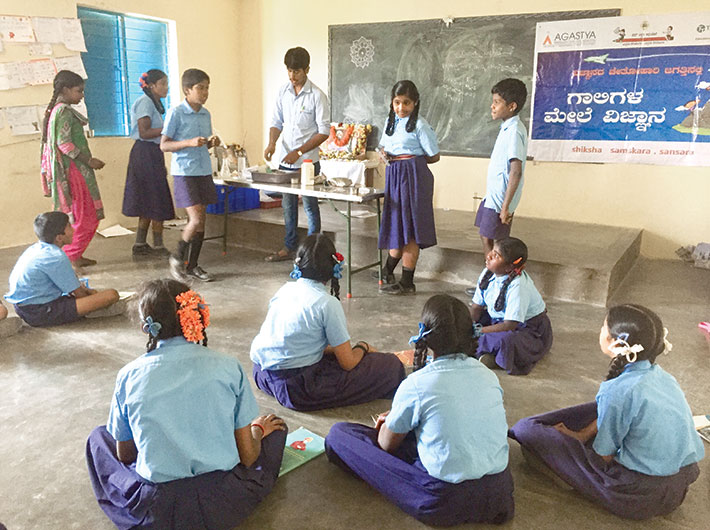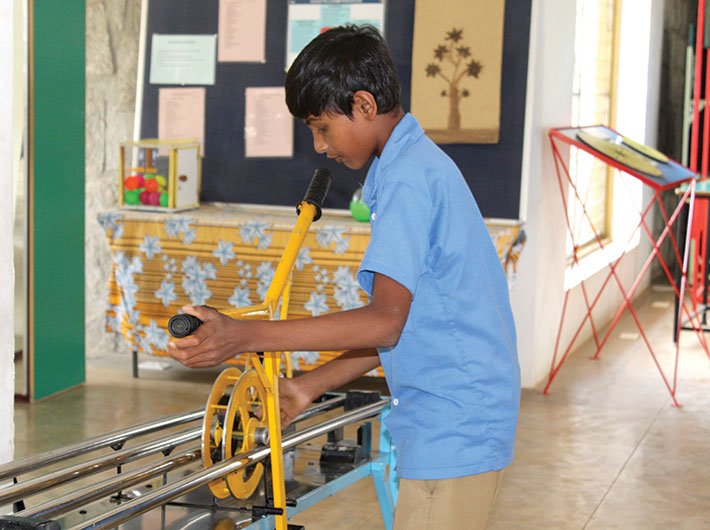Abright yellow van with figures of children playing with a whirligig, a Newton’s cradle, a magnetic compass rolls into the Government Higher Primary School in Kittaganahalli, on the outskirts of Bengaluru. Students in the playground leave what they are doing and mill about it in excitement. For they know some interesting lessons, with hands-on practice, will soon follow.
The van, a mobile laboratory, is part of the
Agastya foundation’s outreach programme to make science, art, and digital literacy more accessible to children and teachers in government schools, mostly attended by those from modest backgrounds.
Inside the school, in a large hall with no furniture, students of Std VII are split into teams of six each. This is their first interaction with the mobile lab. Their instructor from Agastya is Shivraj S, aged 26, who is giving them a chemistry lesson. The topic: forms of matter and chemical reactions. He takes a sheet of newspaper and repeatedly tears it into halves. As he does so, he tells the students to just observe. He then has a question for them: Is anything new formed? Some of the students confidently say, “No.” Others, hesitant, take a little time. Shivraj asks them to think of how matter changes external form – say shape, or state – without the formation of a new substance. The students mention examples such as water freezing into ice.
Shivraj then gives each team a spirit lamp, a porcelain dish, a test-tube holder, and meticulously explains safety procedures to be followed before handing each team a small ribbon of magnesium. After he demonstrates the experiment, they follow along, lighting the magnesium strip and collecting the white, powdery residue in the dish. The students are then encouraged to discuss what they observed. Shivraj joins in and introduces the concept of chemical reactions, and terms like ‘reactants’, ‘elements’ and ‘compounds’. Taking off from the experiment they just conducted, he writes out the equation for magnesium burning and teaches them how to balance equations.
While the students take a mid-day break, Shivraj speaks about the methodology. “Students learn better because they are encouraged to interact and ask questions,” he says. “Better engagement boosts their confidence, and they get their doubts cleared. They are then able to teach their peers in groups.”
After the break, he calls four students from different groups and creates a skit in which each student plays the role of a chemical. The storyline is about four friends fighting to find a place on a small bench in a park. As they enact the skit, their schoolmates in the audience giggle and laugh. But by the time they are done, and Shivraj has built chemistry concepts around the idea of competing for a place, the students have begun to grasp – and wonder at – the moderately complex phenomenon known as a double displacement reaction.
Chaitra, one of the students who watched skit, says she definitely understood the concept better. “Sometimes, school teachers rush through material to complete the syllabus on time,” she says. “But here, it’s easy to understand because of such fun experiments.”
For reinforcing what was taught, Shivraj ends the session with a small quiz. It has taken two hours in all, but he is happy that the lessons he spent so much energy over have engaged the students’ minds and will hence be remembered better.
Fleet-footing it
Agastya has a fleet of 164 vans like the one that Shivraj took to the school in Kittaganahalli. Each is equipped with low-cost science models, experiment kits and auxillary study aids. There’s a driver, and there are two instructors. The vans visit under-resourced schools in urban and rural areas. A time-table is set out so that schools and students know when they have a rendezvous with some exciting learning. So students have come to look forward to such visits. Equally, instructors have been able to build rapport with school teachers, administrators and students. On average, a van visits a school eight times during the course of an academic year. Agastya’s 2017-18 report says its fleet has covered 2,460 schools in 165 districts of the country.
Learning in Kuppam
The instructors are all trained at Agastya’s campus in Kuppam, some 130 km from Bengaluru, but falling in Chittoor district of Andhra Pradesh. They are trained for 25 days every year, and their curriculum and teaching methods are scrutinised and upgraded: one instructor-master-trainer oversees a group 10 instructors. Instructors also share the problems they face, most of which have to be handled on a case-by-case basis. For example, Shivraj mentions how some schools don’t have halls big enough to hold team sessions. Since this is a problem at one or two particular schools, solutions have to be found on-location, and are discussed with the oversight team.
The Kuppam centre is also where visiting children are put through sessions of experiential science learning. There are residential programmes for government school teachers too. The setting couldn’t be better: it’s a 172-acre campus, a few kilometres from Kuppam town, and lies close to the Andhra Pradesh-Karnataka-Tamil Nadu trijunction. Acquired as a barren tract, it has now been developed into a green and shaded enclave. Medicinal plants, trees of cultural significance and other vegetation grow in abundance. There’s a residential area, an astronomy centre, an auditorium and an IT centre.
The hard work of teaching creative learing, however, happens at the Discovery Centre (with separate maths and physics labs), Bio-discovery and Chemistry Centres, the Arts Cluster (with a media lab and a library), and Navrachana, where children are taught to ideate as creative thinkers, solution seekers, and developers of prototypes that could help solve the problems of society.
At the maths lab, a group of Std VII students from a government school in Andhra Pradesh is busy with puzzles. One challenge involves bringing an elephant tied to one end of a rope to the other end without dragging it. Another involved trying to reverse a triangle formed by arranging 10 bangles using no more than three moves. At the physics lab, an instructor is conducting a clarification session for Std VIII students. The topic: sound waves. The instructor says teachers from government schools had requested that the topic be taken up. So how is it done differently here? After a theory session, students are asked to build their own toy telephones using paper cups and string, after which they are allowed to experiment and draw conclusions. “If the string is loose,” says Balaji, who is first to finish his model and speak up, “the vibrations decrease.” That’s a topic for the students to discuss among themselves and with their teacher.

Everything is taught here through observation, hands-on learning, building. In the process, instructors and students both begin to appreciate how science works through hypotheses and testing of hypotheses, and rejection of those that cannot be proved. There are several low-cost models that let children learn concepts like resonance, focal point of lenses, centrifugal force and so on. Children learn about the life cycle of insects by observation at a butterfly park, about medicinal plants at a Mulika Van, where, besides the plants, there is a model of a human body in which plants that benefit particular organs have been planted where the organs are located. At the Pancha Valkala, there are plants and trees of various keystone species.
Over the years, Agastya has also pioneered teacher training programmes supported by companies under their corporate social responsibility (CSR) commitments. The flagship four-day residential course trains government school teachers in pedagogy, following a system based on Piaget’s theory of constructivist learning. Says Manjunath P, head of the teacher training programme, “We train them to become better resource persons by encouraging them to build their own models for teaching difficult concepts. So far, we have trained over 10,000 teachers.”
It’s a system that applies equally to students. At Navrachna, the hub where students are put through experiential learning, there are several successful prototypes, all developed by government school children. Natesh, the innovation lab instructor, says, “We teach children the skills of empathy, observation, prototyping, presentation etc. Then we ask them to watch their surroundings closely and innovate to solve social issues their people face every day.” Some examples: tomato papads (to prevent wastage of tomatoes when prices fall); bio briquettes for chullahs; signboards that signal the arrival, departure and delay of buses; intelligent door locks for toilets to encourage clean toilet habits in rural areas.
Every year, over one lakh students visit the campus, those from highly engaged campuses complete seven-eight visits and those from less engaged ones make two-three visits. Says Padmanabhan Kumar, general manager at the campus, “There is widespread acceptance for Agastya’s unique methods among children, teachers and parents. They consider our staff to be more knowledgeable. There is enormous encouragement for new ideas at Agastya. Children learn more freely as they are not bound in a typical classroom environment.” To make this effective, visits to the campus are systematically planned, with PR teams coordinating with government agencies.
The road ahead
In the years ahead, Agastya wants to focus on a young instructor-leader programme and what it calls Operation Vasantha, aimed at bringing school dropouts into mainstream academics. It was Jayamma, 52, who spoke to the Agastya founder about the dropout rates at schools around Kuppam. With inputs from her, Ramji Raghavan and a team conceptualised a programme to train youngsters and village-level volunteers to conduct free classes, for at least two hours daily, six days a week, to dropouts aged 5-17 years. Last year, the number of Operation Vasantha centres in the country grew to over 500, taking the number of students served by them to 18,000. “It’s a joy to see confident students returning to the mainstream education,” she says. “We plan to increase our reach in many more districts.”
Padmanabhan Kumar adds that the foundation plans to encourage better care of the environment by creating “rainbow gardens of various flowering plants”. “Further, we want to break the walls between different academic subjects and focus on inter-disciplinary learning,” he says. “We also aim to make gamification of learning part of our hands-on approach.”
Classic discovery learning is called the Eureka moment or the Aha! reaction, in which the solution to a problem appears all of a sudden and with felicity. That model has been extended, at Agastya, to learning through the ‘Aah! Aha! Ha-ha!’ experience, in which the learner observes something and is filled with wonder (Aah!), then she solves a problem using what she has observed (Aha!), and enjoys herself in the whole process of experiential learning (Ha-ha!). It’s a methodology all schools could adopt. More power to the method.


